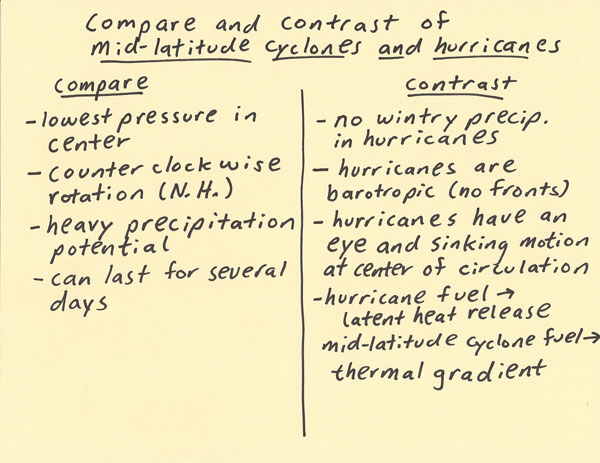
This writing will look at a comparison and contrast between mid-latitude cyclones and hurricanes. Hurricanes are a subset of the genre of tropical system type storms. Other names for tropical system type storms include cyclones, hurricanes, tropical storms, barotropic lows and typhoons. The intensity of the storm and the region it occurs on Earth will influence how it is labeled. Mid-latitude cyclones are typically referred to as the same name of mid-latitude cyclones but are called low pressure systems and baroclinic lows also. Next, a comparison between mid-latitude cyclones and hurricanes will be examined. Both mid-latitude cyclones and hurricanes tend to have the lowest pressure toward the center of the circulation. They both rotate in the same direction for the hemisphere they occur in. They rotate counterclockwise in the Northern Hemisphere and clockwise in the Southern Hemisphere. Each of these types of storms can produce heavy rains and the circulation can last for many days as it moves over the Earth’s surface. There are several differences between mid-latitude cyclones and hurricanes. First, hurricanes typically only have liquid precipitation that reaches the surface (except for the possibility of hail) while mid-latitude cyclones can include wintry precipitation such as snow, freezing rain and sleet. Hurricanes do not have fronts (barotropic system) while mid-latitude cyclones will commonly have cold and warm fronts (baroclinic system). Hurricanes have a very unique environment right at the center of the circulation. The weather can be sunny with light wind at the center of the circulation of a hurricane while the weather tends to be cloudy or stormy at the center of circulation of a mid-latitude cyclone. Mid-latitude cyclones can develop over and strengthen over either water or land while hurricanes need to develop over water and hurricanes weaken once they move on land. The fuel source for a hurricane is warm water while the fuel for a mid-latitude cyclone is the temperature gradient. Hurricanes develop in the tropics while mid-latitude cyclones typically develop in the mid-latitudes and polar regions.  |